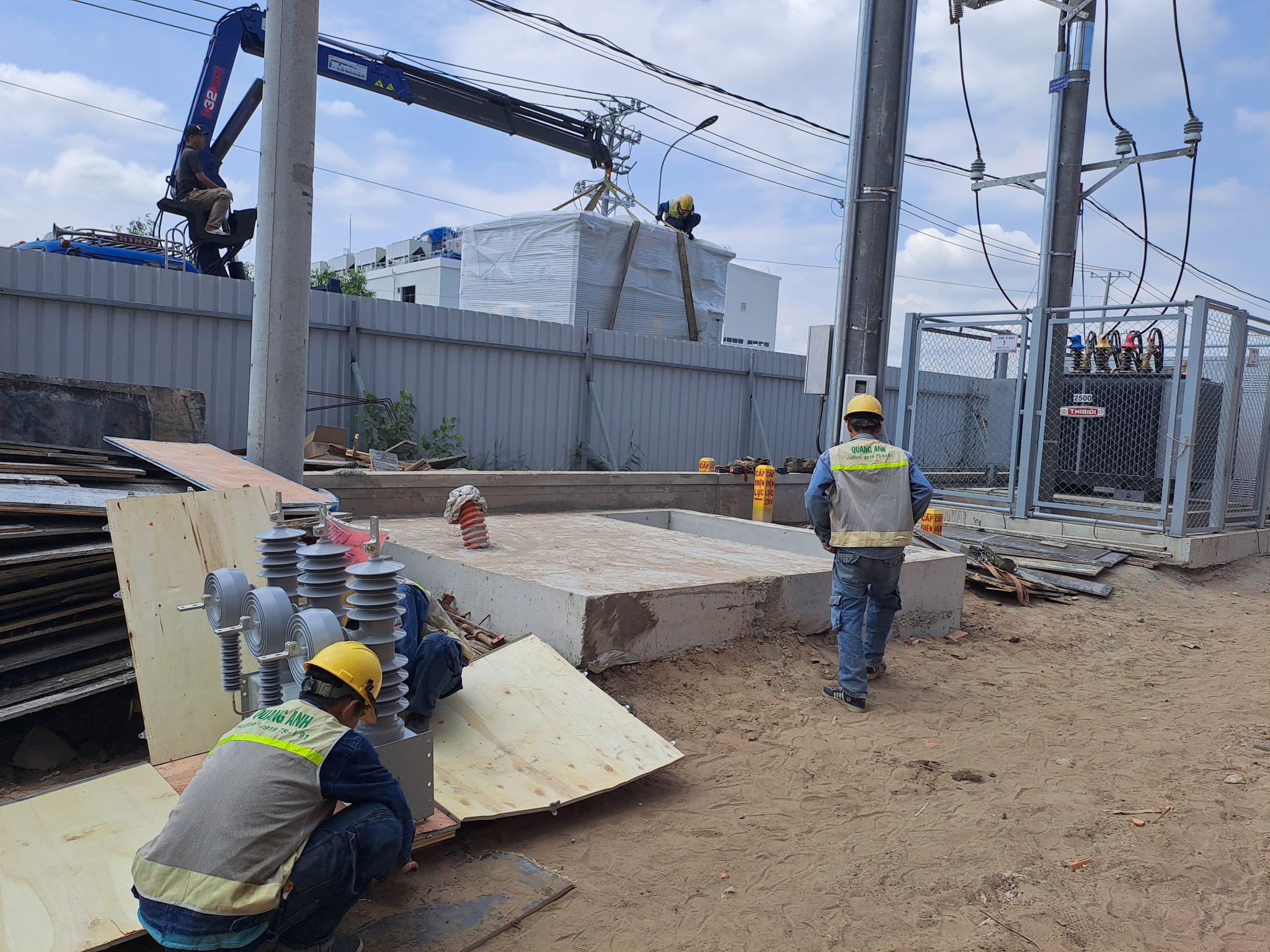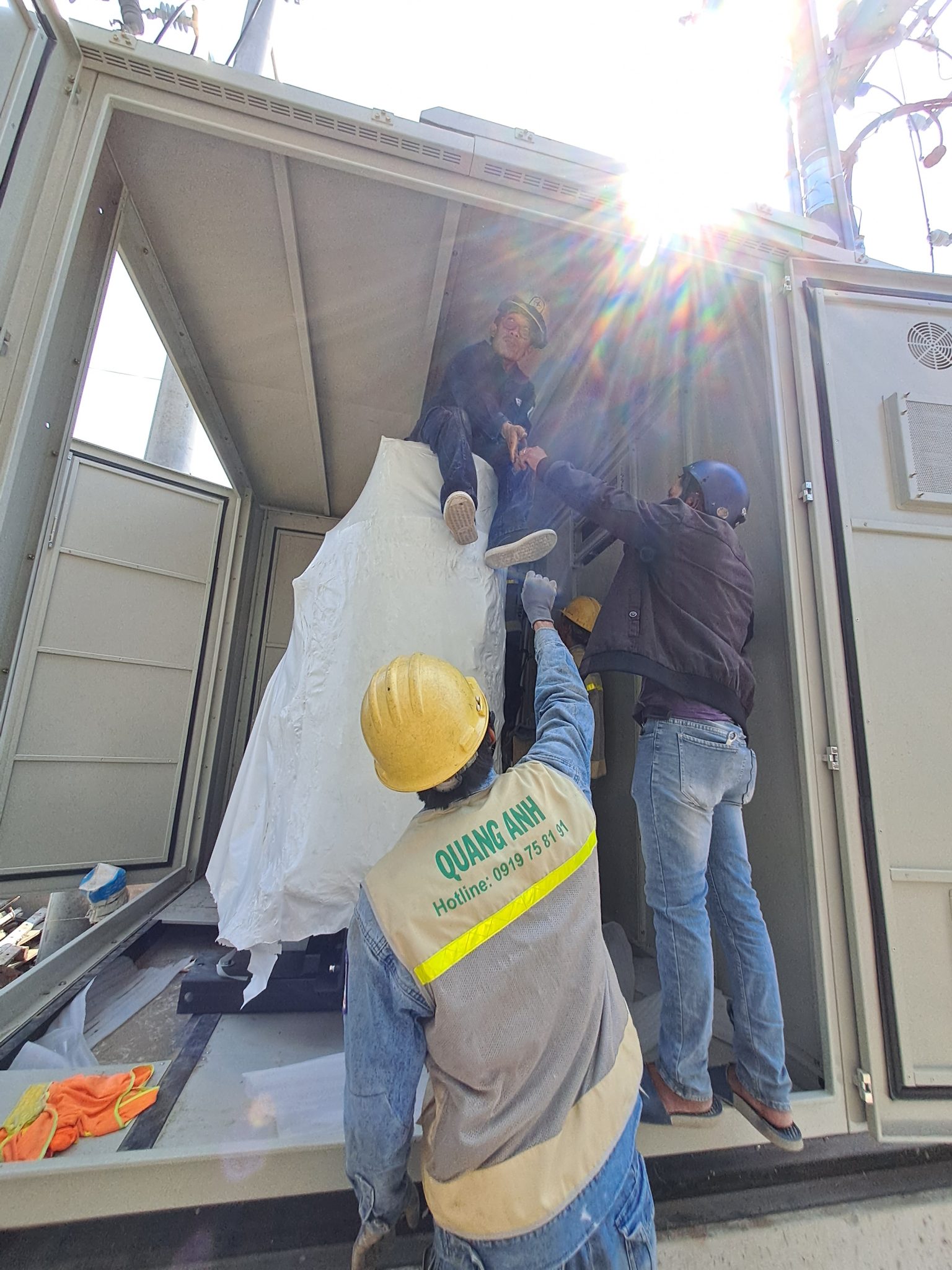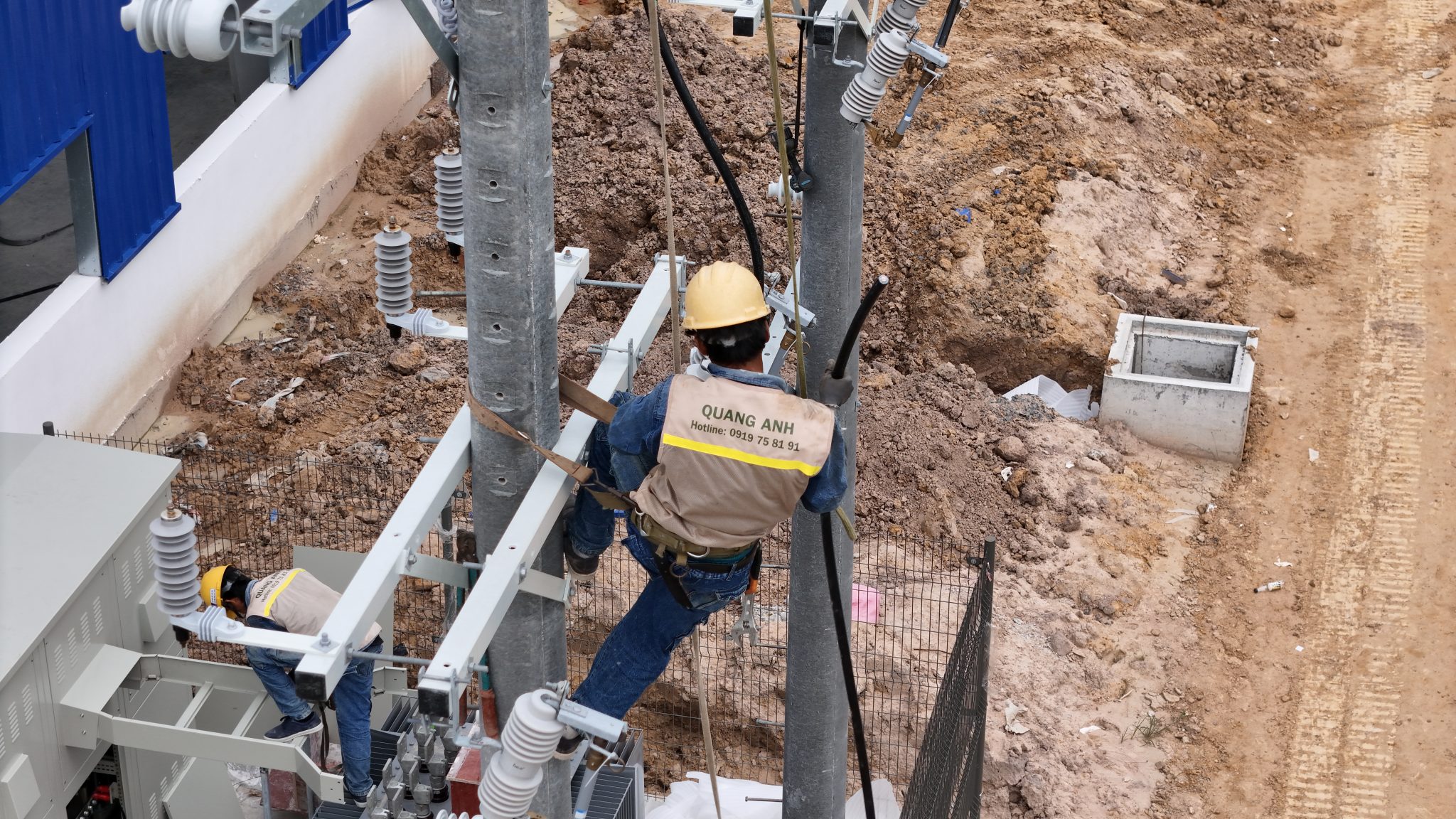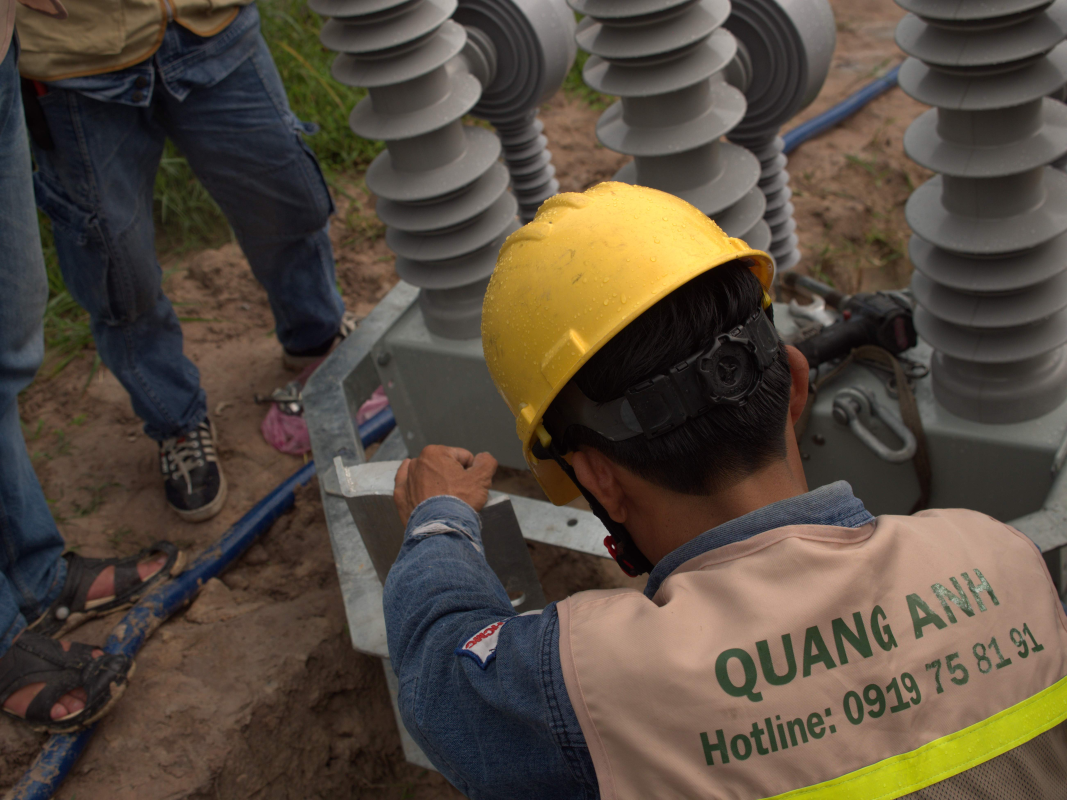Medium voltage systems, substations, MEP, and solar power ensure effective supply and distribution of electricity to factories, particularly in southern Vietnam.
Definition and Context of Medium Voltage Systems
Medium voltage systems, substations, MEP, and solar power are key components of technical infrastructure, ensuring safe and efficient power supply, distribution, and utilization for factories and industrial parks. Rooftop solar power also integrates renewable energy, meeting operational, safety, and legal requirements when connecting to the national grid.
A medium voltage system plays a crucial role in electricity distribution between high and low voltage systems, typically operating at voltages from 1 kV to 35 kV, commonly between 15 kV to 33 kV. In some areas, this can reach up to 220 kV depending on larger scale needs. The primary purpose of medium voltage systems is to transmit power from power plants or medium voltage substations to low voltage substations, acting as an important bridge between supply and end-users.
The context for using medium voltage systems mainly involves the intermediate stage of the electrical grid, operating between high and low voltage levels. In this process, systems use concrete spun poles, ranging from 9 to 12 meters tall. Electrical lines are mainly insulated or bare wires secured to string or pin insulators. For electrical safety, wires and equipment must be securely isolated with standard heights from the ground usually exceeding 9 meters.
The structure of a medium voltage system typically includes essential components such as substations, medium voltage cabinets, electrical insulation wires, and protective and switching equipment. Medium voltage substations help convert the voltage down to appropriate levels to distribute electricity to end-users. Medium voltage cabinets are viewed as the vital nerve center of the system, integrating protective and switching devices to ensure stable and safe operation.
In summary, medium voltage systems are indispensable for ensuring efficient and safe electricity distribution from generation to end-use, and they also enhance transmission performance within the grid. The key to optimal system operation lies in using insulated equipment and wires, alongside rigorous adherence to electrical safety standards.

Legal Procedures and Connection with EVN
The investor prepares a connection application file to submit to EVN, where the power company conducts surveys and agrees on connection standards. After installing and testing standards, interlocking tests and safety inspections occur before signing a power purchase agreement.
Submitting Files and Connection Agreement
- Customers submit a connection application to EVN at the Power Company (PC) or Power Corporation (PCorp) in their locality. The power company then schedules a survey and agrees on connection points and technical requirements.
- Customers need to complete legal procedures for solar power or alignment with existing power planning approved by the authorities before or during this process.
Project Implementation and Preparing for Power Connection
- Once technical agreements are reached, customers sign investment contracts with the Power Company.
- Customers coordinate with governmental bodies to negotiate power line routes, develop investment projects, conduct technical design and environmental protection; facilitate site clearance, obtain necessary permits, procure materials and equipment, and organize construction operations.
- Customers submit documents to meet power connection conditions to the Power Company at least 7 days before connection.
Inspection, Contract Signing, and Connection
- After project completion, customers coordinate with the Power Company to inspect the electricity project. If it meets standards, the Power Company will install measuring meters and sign a power purchase agreement.
- For solar power projects, an electricity sale proposal is needed for the Power Company to survey and install dual-direction meters according to technical standards.
- For large power plants, testing and recognition of COD are required, submitting the test plan to the load dispatch center and Electricity Trading Company before COD testing.

Common Risks and Prevention in Electrical Systems
Technical risks, such as incorrect equipment choices or improper installation, can cause safety issues. Prevent such risks by using standard-compliant equipment, following inspection processes, and having valid connection agreements. Ensure complete legal and technical documentation to avoid legal risks.
Identifying and avoiding common electrical system risks in industrial and residential setups is crucial. Common issues include:
- Phase Loss: A phase loss is an electrical voltage drop occurring on one or all three phases, causing voltage imbalance. If not addressed promptly, it poses risks like electric shocks, electronic device damage, overload on remaining parts, and reduced system efficiency.
- Short Circuits and Fires: These often result from poor technical connections, non-compatible equipment, or overload. Short circuits can raise temperatures, leading to fires and system damage. It’s particularly risky in solar power systems.
- Electrical Overload: Overload occurs from using devices beyond designed capacity or sudden increases in electricity demand. It reduces system efficiency, increasing device damage and fire risks.
- Technical Failures: Design errors, incorrect construction, or using substandard equipment cause damage and compromise system safety.
Effective prevention involves:
- Designing systems with appropriate capacity, adhering to technical standards.
- Regular checks and maintenance to detect early signs like phase loss, overload, or loose connections.
- Using quality, technically cohesive electrical devices from trusted providers like Thibidi, EMC, ABB, Schneider to ensure effectiveness and safety.
- Ensuring strong connections to prevent fires.
- Avoiding overloading or using multiple devices simultaneously beyond system capacity.
- Installing protective gear to guard against phase loss, overload, and shocks.
- Training employees in electrical safety and basic first aid measures.
In conclusion, electrical system risks often arise from phase imbalance, overload, and shorts from substandard or incorrect technical execution. Adhering to strict design and maintenance protocols is optimal for preventing accidents and damages.

Case Study: Rooftop Solar System at Factory
A southern industrial park factory invests in a 1MWp rooftop solar system connected to a 22kV medium voltage grid. The process includes connecting documentation with EVN, installing the PV system, inverters, and conducting equipment verification and commissioning before official operation.
Introduction to Rooftop Solar Systems
Rooftop solar systems at factories are optimal solutions for businesses to cut electricity costs and protect the environment. By installing solar panels on factory roofs, companies can self-produce electricity for operations and lighting. Surplus electricity can be fed back into the grid, earning additional income.
Deploying Rooftop Solar Systems
The deployment begins with a site survey at the factory to measure roof area, evaluate sun exposure, and shadows, check existing electrical systems, and determine electricity usage needs. Factories then receive suitable system design advice based on consumption and roof structure. Next steps involve signing construction contracts, completing legal filings, and registering connections with local power companies.
- Experts conduct thorough surveys to maximize system performance.
- PV systems and inverter technology are integrated to convert electricity compatible with the grid.
- Verification, commissioning, and the grid connection process align with the national grid.
Operational Principles and Benefits
Rooftop solar systems operate by solar panels capturing sunlight and transforming it into direct current (DC). The inverter technology converts this into alternating current (AC) suitable for use in factories. When production exceeds consumption, businesses can sell surplus electricity to the power company, increasing revenue.
Besides cutting electricity costs, the system helps lower roof and indoor temperatures, reducing cooling expenses. A rooftop solar system significantly lowers CO2 emissions, supporting sustainable development strategies. Reports indicate that a system with 250 panels and 3 inverters can generate around 365 kWh daily, catering well to a factory’s production activities.
Investment Costs and Payback Time
Current investment for a 1MW system is approximately 12 billion VND, representing a 50% cost reduction from five years ago. The estimated payback period ranges from 3-4 years due to electricity savings and surplus sales income, allowing businesses to enjoy long-term energy savings.
Therefore, installing a rooftop solar system not only saves costs but also enhances competitiveness by adopting green technology, contributing to environmental protection and sustainable growth.

Medium voltage systems and substations play a vital role in production activities, ensuring efficient and safe electricity supply. Investing in solar energy systems offers strategic long-term benefits, aiding cost reductions and sustainability for businesses.
Contact QuangAnhcons via hotline +84 9 1975 8191 for expert consultation on effective electrical system repair and maintenance in Long An.
QuangAnhcons provides transformer repair services in Long An, ensuring safe and stable medium voltage systems while advising on solar energy solutions for factories and industrial parks.
[contact-form-7 id="7239967" title="Contact form 1"]


Related Posts
Tay Ninh Solar Power Planning: Technical Framework, Grid Interconnection, and Rollout Roadmap
Technical overview of solar planning in Tay Ninh: irradiation, grid capacity, permitting, design, operations, and [...]
Dec
Binh Duong Solar Planning: Regulatory Framework, Grid Interconnection, and an Implementation Roadmap for Factories and Industrial Parks
An overview of Binh Duong solar planning: legal framework, interconnection, design, risk management, and an [...]
Dec
Solar Farm Repair: O&M Workflow, IV Curve Diagnostics, Thermography, Inverter Service and Utility-Scale Safety
A utility-scale solar farm repair plan centered on O&M, IV curves, thermal imaging, inverter service, [...]
Dec
Dong Nai Solar Power Plan 2023–2025: Tri An 1,029 MW, Grid Upgrades and the DPPA Pathway
A complete look at Dong Nai’s solar power plan: Tri An 1,029 MW, irradiation potential, [...]
Nov
Quang Ngai Solar Power Plan 2024–2030: Legal Framework, Irradiance Potential, and Development Roadmap
A complete look at Quang Ngai’s solar power plan: capacity targets, irradiance (PVout), development zones, [...]
Nov
Solar Damage Assessment Services: On-Site Procedures, EL/IV/Thermography Testing & Compliance with Standards
Discover IEC/UL/NEC standard solar damage assessment processes: on-site evaluation, EL and IV curve testing, thermal [...]
Nov
Comprehensive Package Estimate for a 1800MVA 500kV Substation: Scope, Configuration 3x600MVA, Standards and Timeline Management
An overview of the 1800MVA 500kV substation estimate: construction scope, configuration 3x600MVA, GIS/AIS, SCADA, standards, [...]
Nov
Factory Electrical Systems: Comprehensive Design and Implementation Guide
Discover the detailed and safe process of factory electrical systems design and implementation. [...]
Oct
Blueprints Required for Factory Construction Permits
Discover the necessary blueprints in factory construction permit applications, from floor plans to electrical and [...]
Oct
What Are the Requirements for a Factory Construction Permit? A Comprehensive Guide
Explore the documentation and steps needed to secure a factory construction permit for streamlined project [...]
Oct
Factory Construction Permit Procedures in Vietnam: Essential Guidelines and Documents
Learn the procedures for securing a factory construction permit in Vietnam, focusing on document preparation [...]
Oct
Key Steps in the Factory Construction Process
Discover the essential steps and requirements for building factories. [...]
Oct
Comprehensive Electrical Substation Solutions by Quanganhcons
Discover the cutting-edge electrical substation solutions offered by Quanganhcons for industrial applications. [...]
Oct
Investment Costs for a 1MWp Solar Power System and Influencing Factors
Explore the investment costs for a 1MWp solar power system in Vietnam and the influencing [...]
Sep
QuangAnhcons: Elevating Wind Energy Solutions
Explore QuangAnhcons' leadership in wind energy and renewable solutions in Vietnam. [...]
Sep
Electrical Contractor Strategies at Becamex Industrial Park
Discover the strategic advancements and partnerships of the electrical contractor at Becamex Industrial Park. [...]
Sep
Investment Insights for 1MW Wind Energy in Vietnam: Costs and Opportunities
Discover the detailed analysis of costs and opportunities for investing in 1MW wind energy projects [...]
Sep
Advanced Electrical Installation Solutions by QuangAnhcons
Explore advanced electrical installation solutions and modern technology with QuangAnhcons. [...]
Sep
Enhancing Industrial Electrical Services with Quanganhcons
Discover Quanganhcons' expertise in industrial electrical services, offering efficient and sustainable power systems. [...]
Sep
Comprehensive MEP Solutions by QuangAnhcons: From Design to Maintenance Excellence
Discover optimal MEP solutions with QuangAnhcons, dedicated to excellence from design through maintenance. [...]
Sep